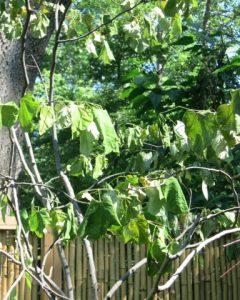
Hi….I live in Toronto, and last Fall I planted a Red Bud ( white blooms ) in my backyard in a part shade location. It is close to 10ft tall, and survived the winter and bloomed. After our recent heat wave, it looks like it’s dead, even after lots of water and rain. All the leaves are wilted and curling up. However, there are shoots at the bottom of the trunk that are healthy ? The leaves are also eaten by something along the edges. Did the heat kill it, or could it be disease ? Can I save the tree or root the small shoots ?
Thank you,
Helen
Sorry to hear about your ailing Redbud. From your photo it is difficult to accurately determine what is wrong with your tree. Redbuds (Cercis spp.) are susceptible to a number of pests and diseases. Did you happen to notice any insects on the lower side of the tree or on the bark? Leaf Hoppers, Scale Insects and Spider Mites are all sucking type of insects, which usually attack the young new growth. This link lists numerous strategies for control of these insects.
Dieback Canker, Leaf Spots and Verticillium Wilt are all diseases, which can infect Redbuds. Dieback/Canker is the most destructive disease that attacks Redbud trees. It is first seen as a tree’s leaves wilt and turn brown. Often cankers can be seen on branches and twigs. The cankers can either be seen as visible cankers on the surface of the branches or as dark sunken areas with black centers. I cannot tell from your photo if cankers are visible.
Leaf Spots can be a problem during wet weather. The appearance of small brown or black spots on the top of leaves is a sign that you have leaf spot.
Lastly, Verticillium Wilt is a common disease that attacks a large number of trees. From your photo it appears as if your tree might be suffering from this disease. In the case of redbuds the soil-borne pathogen Verticillium dahliae causes this disease. This fungus enters the cambium layer of the plant through the roots or injured areas on the trunk and blocks the flow of nutrients within the tissues. This leads to dryness and wilting in affected twigs. There will be brown streaking in the sapwood under the bark and in cross section, an infected branch will show a dark ring or pin-point dark spots. There is no cure for this disease – spraying anti-fungal chemicals will not work. Integrated pest management strategies to try are: 1) prune damaged areas. Maybe this pruning in addition to increasing the vigor of the tree through consistent watering and mulching to maintain soil moisture and moderate soil temperatures will help to keep symptoms in check. Be sure to sterilize pruners with a 10% solution of household bleach between cuts and avoid moving soil or debris from an area of known infection 2) plant resistant or tolerant species in this location. The link below from the Missouri Botanical Garden has lists of plants that are vulnerable to this fungus and lists of plants that are immune to verticillium wilt.
Lastly, you may wish to contact a certified arborist. To find a certified arborist visit the branch of the International Society of Arboriculture here
Good Luck with your tree.

